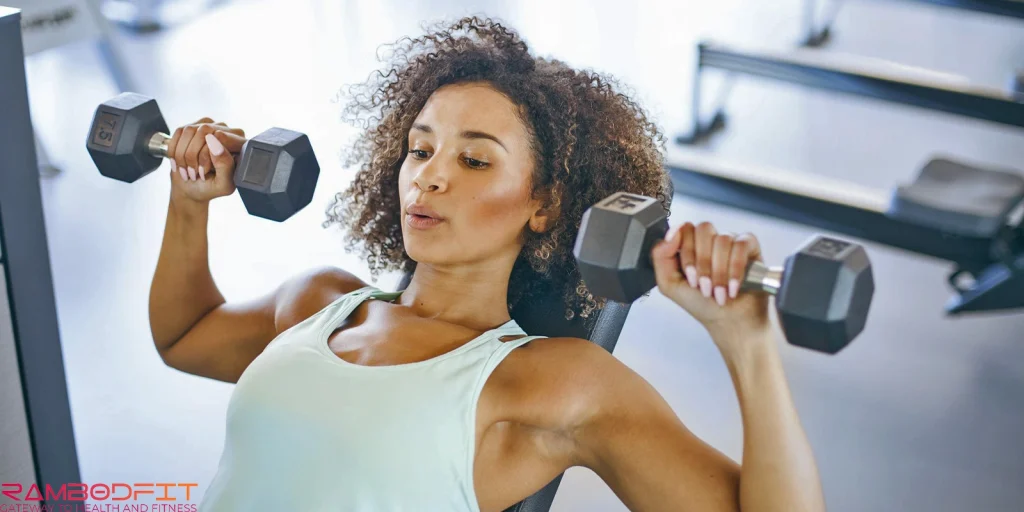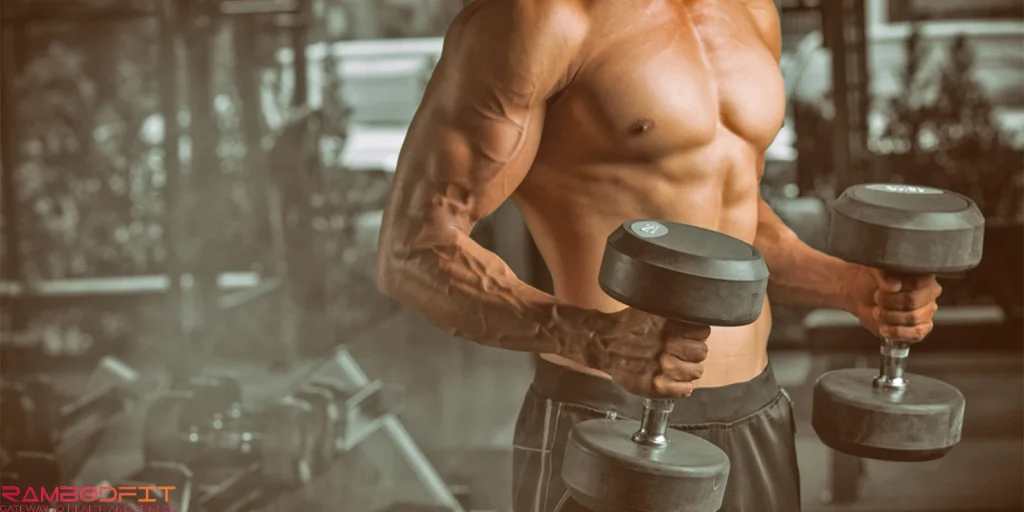


So, here’s the deal—every gym bro, every “expert” on social media, heck, even your uncle with the questionable biceps—everyone swore that muscle growth is all about testosterone. Like, that was the law of the land. No questions asked. Guzzle your protein shake, pray for higher T-levels, and call it a day.
Honestly, I totally bought into it. Sounds logical, right? More testosterone equals bigger muscles. Simple math, however, non-steroidal muscle building is an interesting topic.
But, plot twist: this whole idea came from mixing up two completely different things—your body’s own testosterone (the stuff you make naturally) and the Wild West of anabolic steroids (the stuff people inject or pop like candy). People just mashed them together and acted like they were the same. Spoiler: they’re not. non-steroidal muscle building is something else.
At Rambodfit, let us get into how this whole mess started, and why everything you thought you knew might be backward about non-steroidal muscle building.
Table of Contents

Now, here’s where things get juicy. Lately, science is out here flipping the script. Turns out, muscle tissue isn’t just some dumb lump waiting for hormones to boss it around. Nope. Muscle’s got its own ideas. Like, it might even act like a tiny gland, cranking out its own growth signals when you’re destroying it at the gym.
So, maybe we’ve been giving hormones way too much credit. Maybe the muscle is running its little show, no permission slips are required. Here we go, talk about non-steroidal muscle building facts, the 5 best of them, and that may change your idea about how exercise and the body work from now on.
Alright, let’s just call it what it is—the old-school playbook for getting jacked was basically “testosterone, IGF-1, and growth hormone are your muscle fairy godmothers.” Every textbook, every gym bro on YouTube—same story, just copy-pasted.
Look, they’re not totally wrong; those hormones *do* matter. Testosterone fires up protein synthesis, wakes up satellite cells, and helps patch up your muscles after you wreck ’em. IGF-1’s in the mix too. But lately? Science has started to poke some real holes in the idea that these hormones are the be-all and end-all for muscle gains, at least for us mere mortals who aren’t juicing, also called non-steroidal muscle building bros.
Here’s a fun bit: testosterone doesn’t even get to hang out in your bloodstream for long. We’re talking minutes. Blink and it’s gone. Unless you’re mainlining the stuff like a pro bodybuilder, your natural T levels only get so much done. Most of the time, there aren’t even enough receptors in your muscles to throw a proper party.
Let me tell you about this one guy I trained—42, two kids, dad-bod-turned-deadlift-king. He got his testosterone checked, just for kicks. Low-ish end of normal, nothing special. But the dude was crushing PRs, sleeping like a log, and eating like he actually cared about his health. Then there’s this other guy, younger, allegedly “awesome” testosterone, and… stuck spinning his wheels for months. Make it make sense, right?
Moral of the story: muscle growth isn’t just a numbers game on a lab report.
And here’s the kicker—if you actually want big, visible, crazy anabolic effects from testosterone alone, you’d need to crank it up to levels that’ll basically turn your doctor’s hair white. That comes with a grab bag of side effects you don’t want. We’re talking man-boobs, heart problems, the works. Hard pass.
So yeah, thinking about tweaking your hormones? Only do it with a legitimate doctor on board. No exceptions.
Okay, so here’s the scoop: muscle tissue? It’s not just some dumb meat waiting for orders from your hormones. Nope. Turns out, since around 2010, scientists started realizing muscles have opinions—and they’re not afraid to speak up.
Wild, right? The muscle is actually an endocrine organ. Yeah, like, it can straight-up send out its chemical messages. It can boss itself around (autocrine style) or nudge its neighbors (paracrine vibes). Basically, it’s got a group chat and isn’t shy about spamming it.
The big deal? Myokines. These are protein messengers your muscles crank out whenever you’re working out. We’re talking Interleukin-6 (IL-6), Irisin, Myostatin, Follistatin—the gang’s all here.
It’s like your muscles are texting the rest of your body, “Hey, we’re busy down here. Get on our level.” And honestly, your body listens. Non-steroidal muscle building can be interesting.
Alright, let’s talk about myostatin. It’s like that grumpy gym manager who tells you, “Whoa, buddy, that’s enough muscle for today.” It’s this protein your muscles spit out to slam the brakes on growth—nature’s way of keeping you from turning into the Hulk and tripping over your own biceps.
The funny thing is, when you’re stressed out (think: chain-smoking, starving yourself, or grinding yourself into the ground with too much training), myostatin cranks up even more. So yeah, your own body can totally betray your gain if it thinks you’re living wrong. Rude.
Now, follistatin—here’s the cool part. It’s like the rebel that sneaks past myostatin and yanks the brake cables out. It latches onto myostatin and says, “Nope, not today,” letting your muscles actually grow. You can’t just will your body into making more follistatin by hitting the gym harder (if only, right?), but scientists are out there brewing up things like YK-11, hoping they can hack this system for bigger pipes or, you know, actual medical reasons.
IL-6: Ah, everyone thinks it’s just about inflammation, but it’s got more layers than an onion. During workouts, your muscles pump out IL-6, and suddenly it’s not just about swelling—it’s hustling glucose around and torching fat. It’s like your body’s personal pit crew keeping the engine running. I remember going into a workout on an empty stomach, expecting to crash and burn, but—surprise—I felt unstoppable. Turns out that spike of IL-6 is like your muscle screaming, “We got this, let’s roll!” Awesome.
And then there’s Irisin. This one’s wild. When you crush those long runs or go ham on the bike, your muscles release irisin, which tells your boring white fat to level up and turn into calorie-burning brown fat. It’s not just muscle getting bigger—it’s muscle acting like the boss of your whole metabolism, telling fat where to go. Who knew your legs had so much authority? That is the beauty of non-steroidal muscle building.

Alright, here’s the deal in plain English: systemic hormones and those local autocrine signals? They’re not duking it out like rivals in a bad superhero movie. They team up—but only when the stars align just right.
Now, when folks pop anabolic steroids or whatever, that’s like hitting the gas with rocket fuel. You’ll see wild effects—because you’re cranking hormone levels way past what your body would ever do on its own. But in the real world, when you’re not juicing, most of the muscle-building wizardry goes down inside the muscle itself. There’s this whole secret convo happening between chemicals, especially when you’re fried from a brutal set. Stuff like IGF-1 and MGF kick in, all happening right where the action is.
Let’s break it down, bullet-point style:
• Big hormones like testosterone? Sure, they’ll help you out. But unless you’re constantly living at superhuman levels (spoiler: you’re not, unless you’ve got a pharmacy in your gym bag), they’re not the main show.
• The real MVPs are things like muscle tension, straight-up damage, and burning metabolic stress. That’s what makes your muscles cough up the good stuff locally.
• The way you train—how hard, how much, and how often—decides which path gets the spotlight.
Bottom line? If you’re staying natural, you can’t just pray to the hormone gods and hope for gains. You gotta bring the chaos. Train smart, mix it up, and keep your muscles guessing (and suffering a bit). That’s where the real growth happens. Non-steroidal muscle building can also be hard.
Alright, here’s the real talk version:
So, if you’re tryna get swole without juicing up on PEDs, non-steroidal muscle building. Here’s the deal:
1. Quit freaking out about your test levels unless your doctor says you need to. Seriously. Put the microscope down. The hormones that matter are the ones your body cranks out after you lift.
2. Build your workouts around stuff that makes your muscles *work*—like, really grind. Think heavy lifts (mechanical tension) and chasing that burning, wobbly-leg feeling (metabolic fatigue). That’s what fires up the muscle-building signals—not some magic pill.
3. Recovery isn’t just a buzzword. If you don’t chill sometimes, your body freaks out and pumps out too much myostatin, which is like hitting the brakes on your gains. So, yeah, nap like a cat, and don’t skip rest days.
4. Mix it up. Hit the weights for growth, do some cardio for that sweet Irisin (look it up, it’s cool), and throw in some stretching or yoga so your joints don’t turn into rusty hinges.
5. Don’t just count your protein and carbs. Your tiny cell parts need vitamins and minerals to work right, and those little guys are running the real show behind the scenes.
Bottom line: Train hard, rest harder, eat smart, and don’t overcomplicate it. You got this non-steroidal muscle building.

Man, remember when everyone thought muscle was just this dumb slab of meat, just chilling there, waiting for a hit of testosterone or whatever? Yeah, turns out, that muscle’s got way more going on upstairs. It’s not just sitting around—it’s chatting with the rest of your body, running the show, and even pumping out its hormones, which is non-steroidal muscle building. Wild, right?
If you’re training without the “magic juice,” honestly, that’s kind of awesome. You’re not just a puppet yanked around by your hormone levels. You can tweak your biology to build muscle, all-natural, no sketchy vials required. Non-steroidal muscle building is called.
So, next time you’re grinding through a set, don’t think you’re just heaving around iron. You’re hacking your system, flipping all sorts of fancy switches under the hood. And let’s be real, that’s way cooler than getting your gains from a syringe, and non-steroidal muscle building is something worth doing.
Further Studies & Resources about non-steroidal muscle building.
Let’s be real—those natural T-boosters at the supplement store? Mostly hype. Maybe you’ll notice a slightly better mood or a bit more “drive” (wink), but actual muscle gain? Meh. If you’re expecting your biceps to pop just from a pill, keep dreaming. Real muscle comes from putting in the work, not from a bottle. Non-steroidal muscle building is a long journey you should accept.
Could be, but it’s not the whole story. Yeah, myostatin’s like the body’s internal “no fun allowed” sign for muscle growth, especially if you’re stressed out or not sleeping right. Tweak your recovery, eat decent food, and, please, get some sleep. That’ll do way more than obsessing over some single protein.
Honestly? You need both. Heavy lifting wakes up those stubborn, lazy muscle fibers, while volume training just cooks your muscles in metabolic chaos. They’re like peanut butter and jelly—sure, you can have just one, but why miss out on the magic of both? Mix it up and get the best of both worlds which leads to non-steroidal muscle building.